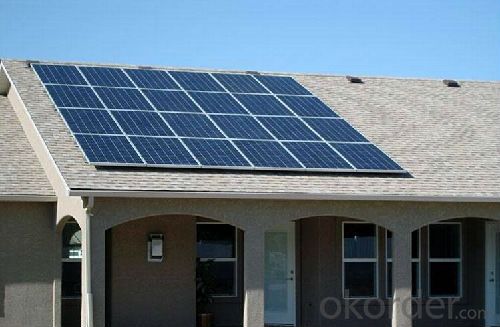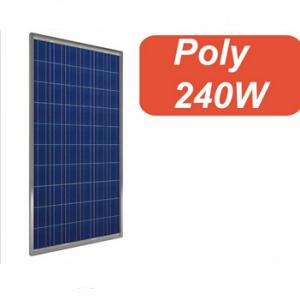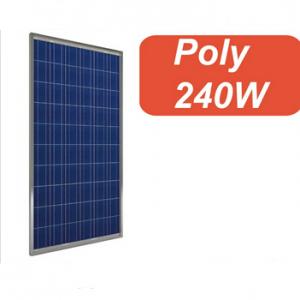Solar Panel 240W Polycrystalline Solar Module
- Loading Port:
- SHANGHAI
- Payment Terms:
- TT or LC
- Min Order Qty:
- 6000 watt
- Supply Capability:
- 10000000 watt/month
OKorder Service Pledge
OKorder Financial Service
You Might Also Like
Description:
Solar modules use light energy (photons) from the sun to generate electricity through the photovoltaic effect.
The majority of modules use wafer-based crystalline silicon cells or thin-film cells based on cadmium telluride or silicon.
The structural (load carrying) member of a module can either be the top layer or the back layer.
Cells must also be protected from mechanical damage and moisture. Most solar modules are rigid, but semi-flexible ones are available,
based on thin-film cells. These early solar modules were first used in space in 1958.
CNBM Solar photovoltaic (PV) Panel is designed for large electrical power requirements.
It is the optimal choice for both on-grid and off-grid power systems.
CNBM Solar panel offers high performance of power per square foot of solar array.
Monocrystalline silicon(c-Si): often made using the Czochralski process. Single-crystal wafer cells tend to be expensive,
and because they are cut from cylindrical ingots, do not completely cover a square solar cell module without a substantial waste of refined silicon.
Hence most c-Si panels have uncovered gaps at the four corners of the cells.
Characteristics of Solar Monocrystalline
I. Solar Cell : High efficiency crystalline solar cell.
Even if under the weak light, the solar module can produce maximum power output.
II. Tempered glass (toughened glass): Anti-reflecting coating and high transmission rate glass increase
the power output and mechanical strength of solar module.
III. EVA and TPT: Using high quality EVA and TPT to prevent destroying and water.
IV. AI frame: Without screw, corner connection. 6 holes on the frame can be installed easily.
V. Junction box: Multi function junction box with water proof.
VI. Long lifetime: ≥25 years; Less power decrease.
VII. Good performance of preventing from atrocious weather such as wind and hails.
VIII. Resisting moisture and etching effectively, not effected by geology.
IX. The certificate issued by international authority: UL, TUV, IEC, VDE, CE.
Characteristics | Unit | 240W |
Maximum Power (Pmax) | W | 240 |
Power Tolerance | W | (0,+5) |
Maximum Power Voltage (Vmp) | V | 30.50 |
Maximum Power Current (Imp) | A | 7.86 |
Open Circuit Voltage (Voc) | V | 37.70 |
Short Circuit Current (Isc) | A | 8.50 |
Module Efficiency (ηm) | % | 16.35 |
Dimension of module | mm | 1480*992*40mm(64.6*39.1*1.6inch) |
Pmax Temperature Coefficient | %/C | -0.44 |
Voc Temperature Coefficient | %/C | -0.32 |
Isc Temperature Coefficient | %/C | 0.44 |
Maximum System Voltage | VDC | 1000(TUV);600(UL) |
Maximum Series Fuse Rating | A | 15 |
Operating Temperature | C | -40~ +85 |
NOCT | C | 45±2 |
STC:1000W/m2.AM1.5 and 25C cell temperature, NOCT : Nominal Operating Cell Temperature | ||

FAQ:
1. How long will my inquiry get response?
Your inquiry related to our products or prices will be replied within 24 hours.
2. Can I get professional service and suggestion?
Well-trained and experienced staffs to answer all your questions in fluent English.
3. Do you accept OEM or customized design?
OEM & ODM, any your customized lightings we can help you to design and put into product.
4. What if I need specific design?
Distributorship are offered for your unique design and some our current models.
- Q:Can solar panels be installed on commercial buildings?
- Yes, solar panels can be installed on commercial buildings. In fact, many businesses and organizations are increasingly opting for solar panel installations to reduce their energy costs and environmental impact. By harnessing sunlight and converting it into electricity, solar panels provide a sustainable and renewable source of power for commercial operations.
- Q:Can solar panels be used for powering water treatment plants?
- Yes, solar panels can be used for powering water treatment plants. Solar energy can be harnessed and converted into electricity to operate the various processes involved in water treatment, such as filtration, disinfection, and pumping. This renewable energy source can help reduce reliance on fossil fuels, lower operational costs, and contribute to a more sustainable and environmentally-friendly water treatment process.
- Q:i need to make a mini-solar car which shouldn't cost much. it's for my science project. for now, i just found out how to make a solar panel using copper oxide, but it does not generate enough power to power up the engine of the toy car [ the small engine they used in the toys, like from TAMIA]
- Have okorder . This will absolutely save yourself!
- Q:Can solar panels be installed on a boat?
- Yes, solar panels can be installed on a boat.
- Q:Can solar panels be used to power a data center?
- Yes, solar panels can be used to power a data center. Solar energy can be harnessed through photovoltaic panels and converted into electricity to power a data center's operations. This approach helps reduce reliance on traditional energy sources and promotes sustainability. However, the feasibility and effectiveness of using solar panels will depend on factors like the size of the data center, available sunlight, and energy requirements.
- Q:Can solar panels be used in areas with high levels of snowfall?
- Yes, solar panels can be used in areas with high levels of snowfall. However, the efficiency and performance of solar panels may be reduced during snowy conditions due to reduced sunlight exposure. Regular snow removal and tilt mounting options can help mitigate the impact of snow accumulation and ensure optimal energy production.
- Q:I am moving to Hawaii and the house we are living in has independent electricity. (solar panels and gas powered generators.)
- specific. fairly, here is what you % (i'm holding this ordinary on objective): The panels themselves -- how large a close-by relies upon on effortless potential intake and how plenty potential you will get on effortless. That, in turn , relies upon on climate. you would be wanting extra in Seattle than Tuscon, as an occasion. i could wager something in the neighborhod of 0 sq. ft. relies upon additionally on haow many units (printers, etc.) you have. you would be wanting a potential storage device. Lithium components the perfect poser density (of off-the-shelf stuff) yet an effortless motor vehicle battery works properly and is sturdy. And, of course, a administration device to administration the potential technology/storage/use so each little thing works collectively with out that stressful scent that tells you you in undemanding terms cooked some hundred greenbacks properly worth of equuipment! :)
- Q:Can solar panels be used in areas with high levels of rainfall?
- Yes, solar panels can be used in areas with high levels of rainfall. While excessive water exposure can affect the performance of solar panels in the short term, modern solar panels are designed to withstand different weather conditions, including rain. Proper installation and maintenance can ensure their efficiency and longevity, even in areas with high rainfall.
- Q:Can solar panels be integrated into buildings?
- Yes, solar panels can be integrated into buildings through various methods such as rooftop installations, solar facades, and building-integrated photovoltaics (BIPV). These approaches allow for a seamless integration of solar panels into the building's structure, providing renewable energy generation without compromising the overall aesthetics or functionality of the building.
- Q:How do solar panels affect the grid during times of high electricity demand?
- Solar panels can help alleviate the strain on the grid during times of high electricity demand by generating clean and renewable energy directly from the sun. When solar panels produce surplus electricity, it can be fed back into the grid, increasing its supply and reducing the need for traditional power sources. This helps stabilize the grid and meet the increased demand while also reducing the reliance on fossil fuel-based power plants.
1. Manufacturer Overview |
|
|---|---|
| Location | |
| Year Established | |
| Annual Output Value | |
| Main Markets | |
| Company Certifications | |
2. Manufacturer Certificates |
|
|---|---|
| a) Certification Name | |
| Range | |
| Reference | |
| Validity Period | |
3. Manufacturer Capability |
|
|---|---|
| a)Trade Capacity | |
| Nearest Port | |
| Export Percentage | |
| No.of Employees in Trade Department | |
| Language Spoken: | |
| b)Factory Information | |
| Factory Size: | |
| No. of Production Lines | |
| Contract Manufacturing | |
| Product Price Range | |
Send your message to us
Solar Panel 240W Polycrystalline Solar Module
- Loading Port:
- SHANGHAI
- Payment Terms:
- TT or LC
- Min Order Qty:
- 6000 watt
- Supply Capability:
- 10000000 watt/month
OKorder Service Pledge
OKorder Financial Service
Similar products
New products
Hot products
Hot Searches
Related keywords




























